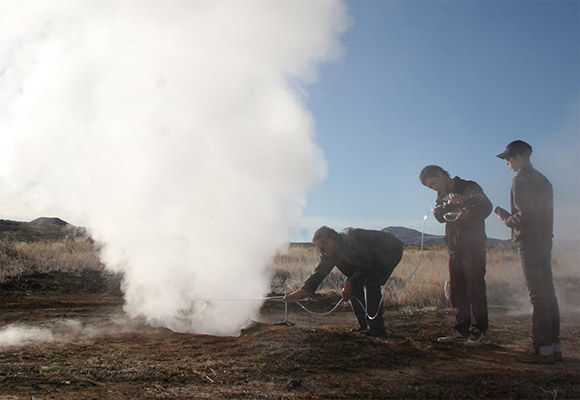Overview
The Great Basin Center for Geothermal Energy (GBCGE) was informally organized within the Mackay School of Mines at the University of Nevada, Reno in May 2000. The formation of the GBCGE was in response to new congressional initiatives for accelerated development of renewable energy sources in the western US. Funding has primarily been provided by the U.S. Department of Energy, and supports research into many aspects of geothermal exploration and development, as well as education. Dr. Bridget Ayling is currently the Director of the Great Basin Center for Geothermal Energy.
Many of our research and exploration projects have been published at the Geothermal Rising (formerly Geothermal Resources Council) annual meetings and at the Stanford Geothermal Workshop. For publications, visit the Geothermal Rising library, search the International Geothermal Association (IGA) conference paper database, or contact faculty and staff directly.

Vision
The Great Basin Center for Geothermal Energy to become internationally recognized as a center of excellence in promoting the development of geothermal energy as an economically viable and clean energy source.
Mission
The mission of the Great Basin Center for Geothermal Energy is to work in partnership with U.S. industry to establish geothermal energy as a sustainable, environmentally sound, economically competitive contributor to energy supply in the western United States by:
- Providing needed and timely information on geothermal resources;
- Identifying key policy, regulatory, economic, social/cultural and environmental issues;
- Identifying and evaluating new and emerging technologies for geothermal energy exploration, production, transmission and use;
- Fostering new scientific and technological developments; and
- Facilitating outreach, training and communication between geothermal energy stakeholders.
Expertise
Research
- Develop and refine techniques to identify and evaluate geothermal systems
- Validate new methods of exploration and reservoir characterization
- Develop conceptual models for different types of geothermal systems
- Understand favorable structural settings for geothermal systems
- Numerical modeling, fracture and uncertainty analysis
- Reservoir fluid and heat flow modeling
- Develop advanced exploration workflows using geostatistical and machine learning tools and approaches
Education
- Train MS and PhD students in geosciences and engineering fields relevant to the geothermal industry
- Lead the National Geothermal Academy summer program
- Collaborate with national and international partners via capacity-building activities and training initiatives
- Engage undergraduates and graduates in industry-sponsored internships
- Provide data and information on geothermal resources within the state
Exploration
- Detailed analysis and assessment of regional resources
- Geologic and structural mapping
- Spectroscopy to identify mineralogy in the field, hand samples, and drill core
- Remote sensing to map geothermal indicator minerals
- Fault identification using low sun-angle photography and LiDAR data
- 2 meter temperature surveys
- Trenching across seismically active faults
- Gravity data collection and analysis
- 2D/3D seismic survey interpretation
- Geodetic analysis of crustal strain
- Geochemical analysis of soil gases
- Geochemical and isotopic analysis of spring and well fluids for geothermometry and ground water linkage
- Real-time seismic monitoring of active reservoirs
- Micro-earthquake assessment of induced seismic hazards
- GIS compilation of data
- 3D modeling of geothermal systems
- Ground displacement monitoring using InSAR data
- Drill core analysis
